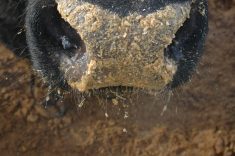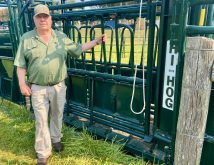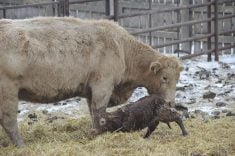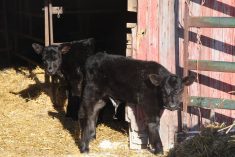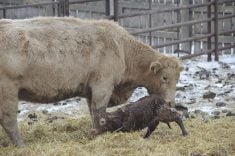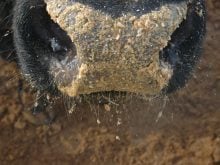Minimizing fecal contamination is one of the best ways to optimize calf health, veterinarians say.
In other words, limit the poop in the group.
“We’re really trying to reduce that exposure of the baby calf to adult feces as much as possible. We can’t eliminate that, but we can reduce the kind of load that they’re exposed to,” said John Campbell of the Western College of Veterinary Medicine at the University of Saskatchewan in Saskatoon.
“We want to get a healthy calf out and get colostrum and all that sort of stuff, but we also want to minimize the amount of adult feces that calf is exposed to because most of the bugs that cause diarrhea in baby calves and scours and things like that, they’re carried normally by healthy cows,” he said.
Read Also

Lending policy still focused on primary producers: Farm Credit Canada
Farm Credit Canada said it has not changed its business practices and remains committed to supporting all producers, after a report from an Ottawa-based media outlet claimed otherwise.
“They’re walking around with those same bacteria and viruses in their intestinal tract and not causing any problem in the adult, but it can cause significant disease in the baby calf.”
Time of year, size of herd and calving infrastructure all factor into the biosecurity formula.
Campbell said outdoor operations with limited infrastructure can use a Lacombe calving system that uses a separate wintering area followed by a calving area. Cow-calf pairs are then moved to paddocks or pastures as soon as possible. Several paddocks allow different ages of calves to be separated from one another.
Alternatively, the Sandhills system uses a calving field where the cow-calf pair remains and the pregnant cows are moved onto cleaner ground after a week or two. This procedure continues until the last group of cows has calved.
This system is particularly good with larger birthing operations using multiple calving areas. It is also easier to move pregnant cows to the next calving area instead of moving cow-calf pairs.
“So the ones that haven’t calved yet, maybe you have 500 cows, they’d all go onto that area. Maybe after 100 have calved you move the 400 that haven’t calved off to the next one and let 100 calve on that area. And then you move 100 onto the next one,” he said.
Many purebred producers are in the thick of things right now so they should take expectant mothers to clean, well-bedded calving pens, free of manure from other animals, although Campbell admits that’s easier said than done.
Cleanliness is a top priority for Julie-Anne Howe and husband Kelly, who started calving 350 head of purebred Charolais and Red Angus Jan. 15 near Moose Jaw, Sask.
“We try and keep our environment as clean as possible in terms of fecal contamination to avoid the viral loads that could cause disease,” said Julie-Anne.
“Environment trumps all sorts of disease prevention protocol, so you can’t vaccinate your way out of a bad environment.”
She and Kelly are “militant” in their calving barn by cleaning daily and using an aerosol disinfectant.
“Cleanliness is close to godliness in terms of disease prevention,” she said.
In an effort to maintain calf health, Campbell said the cow-calf pair should be moved to another clean, well-bedded environment shortly after birth and the calf is mothered up.
“It’s nice if there’s a nursery pen or a nursery area where we can turn these cow-calf pairs once the calf is sucking and dried off,” he said.
A basic way to reduce fecal contamination in an outdoor calving pen is to put pregnant cows in just before the calving season.
“We talk about a wintering area, calving area and maybe multiple calving areas if you’ve got a big herd. If your calving (area) gets contaminated over time you might want to stage that if you can, but again it’s always easier said than done,” said Campbell.
The Howes move their calves through a series of pens. Pregnant cows come in one side of the yard and as they calve, they move in a circuit through the yard and onto a half section of land.
“As soon as a calf is about 10 days old and well mothered up, they go out onto a half section again and they don’t come back in,” she said.
“We start the 15th of January and then we calve again on the 15th of August and those calves are well out on pasture and that really decreases any kind of disease load if they’re out on pasture.”
Steve Pylot of Meadow Lake, Sask., shifted his calving from March to May to work with Mother Nature and minimize exposure and contamination.
“We’ve moved to May calving so our calving pens, if you will, are not feedlot pens or cow-calf pens. Our pens are our pastures of 20 to 30 acres,” said the commercial Black Angus producer.
“So by just the square footage, the warm weather, rain and lack of confinement tend to mitigate a lot of that stuff on its own.”
As a result, bacterial contamination has not been a problem and he no longer gives scours vaccines.
While a later calving season comes at the cost of lower-weight animals in fall, calf health has improved with minimal doctoring, he said.
“We don’t check cattle as often and we don’t doctor cattle as often because they are not in confinement as much and they’re not as stressed with the environment.
“The more you confine cattle, the more they have a higher incidence of exposure.”
Campbell said respiratory disease, as well as inhalation of viruses and bacteria, are big components of biosecurity, which producers can minimize by maximizing the immunity of the newborn calf through vaccinations.
“We often vaccinate the cow with scours vaccines and things like that so that she passes on that immunity to the calf in the colostrum and then sometimes the vaccination of the calf,” he said.
It’s usually not a concern with calving outside, but can be an issue inside barns, particularly with dairy operations since a high number of animals will increase humidity inside the barn.
“The cows are carrying around the bacteria and viruses in their respiratory tract that can cause respiratory disease. The cows have immunity. They don’t seem to have bothered adult cows, but if calves inhale those viruses to any great extent they can get respiratory disease down the road too,” said Campbell.
It tends not to be an issue in the beef industry, but the same concept applies.
“We don’t see a lot of that in the beef industry, but in some purebred guys where they keep their calves in the barn for too long, we can see the same concept,” he said.
Sufficient space and ventilation are key.
The Howes vaccinate extensively by giving newborns an intranasal for respiratory disease as part of their animal health protocols, which requires facilities to access the calves.
They use eight individual maternity pens where the cow and calf stay together. While it’s seldom used, a larger area in the back of the barn is reserved for up to 65 animals when temperatures drop to extremes.
Weather is always a factor with biosecurity and like Pylot, many producers have moved their calving later in the year. That’s not always an option for purebred operations.
While intensive monitoring helps during calving, wet calves are prone to hypothermia until they get dried off and fed.
“Even a normal calf can become hypothermic very quickly” said Campbell.




